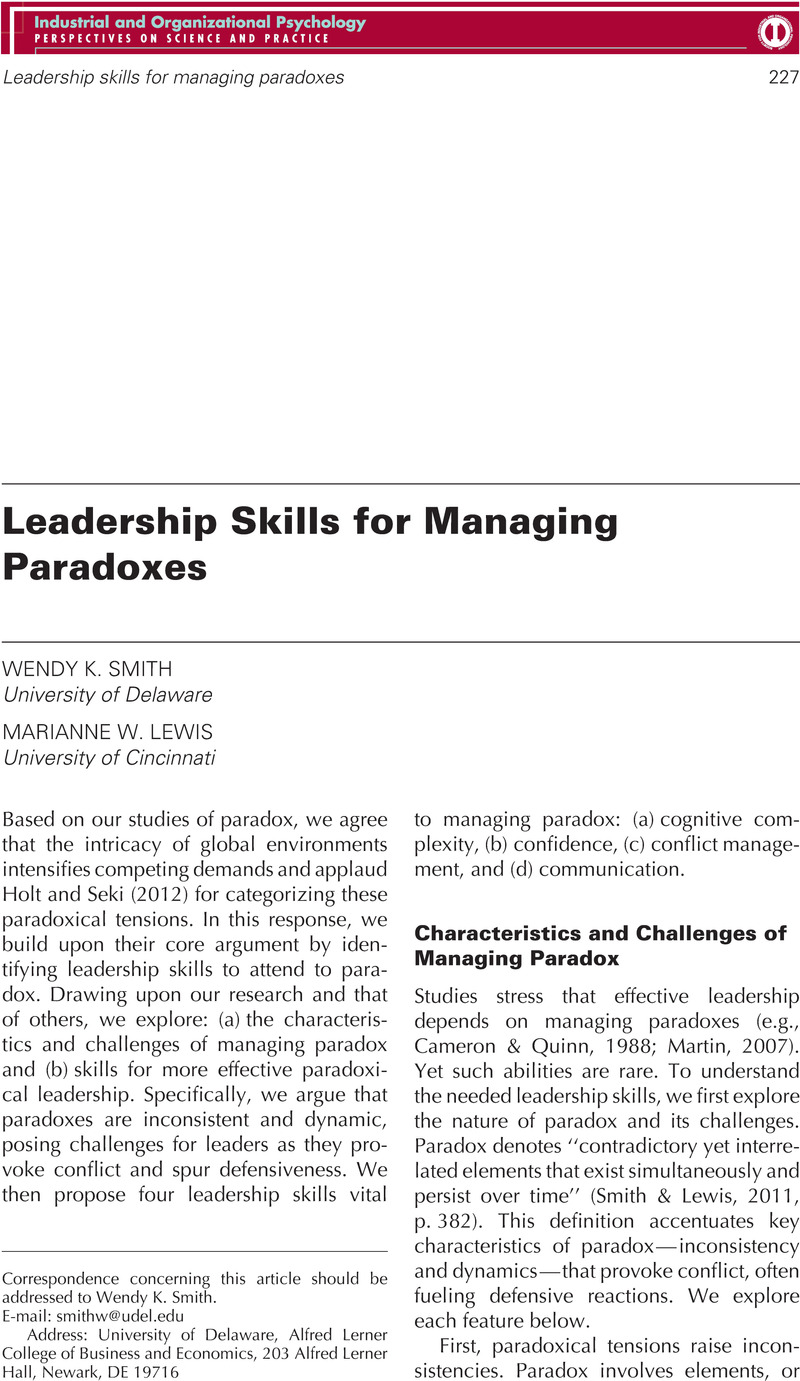Crossref Citations
This article has been cited by the following publications. This list is generated based on data provided by Crossref.
Bednarek, Rebecca
Blumenfeld, Stephen
and
Riad, Sally
2012.
Union‐division: on the paradoxes of purpose and membership scope in union mergers.
Industrial Relations Journal,
Vol. 43,
Issue. 6,
p.
548.
Seki, Kyoko
and
Holt, Katherine
2012.
Global Leadership to Transform the World.
Industrial and Organizational Psychology,
Vol. 5,
Issue. 2,
p.
248.
Lavine, Marc
2014.
Paradoxical Leadership and the Competing Values Framework.
The Journal of Applied Behavioral Science,
Vol. 50,
Issue. 2,
p.
189.
Horst, Sven-Ove
and
Moisander, Johanna
2015.
Paradoxes of Strategic Renewal in Traditional Print-Oriented Media Firms.
International Journal on Media Management,
Vol. 17,
Issue. 3,
p.
157.
Kauppila, Olli‐Pekka
and
Tempelaar, Michiel P.
2016.
The Social‐Cognitive Underpinnings of Employees’ Ambidextrous Behaviour and the Supportive Role of Group Managers’ Leadership.
Journal of Management Studies,
Vol. 53,
Issue. 6,
p.
1019.
Chandwani, Rajesh
Agrawal, Narendra M.
and
Kedia, Ben L.
2016.
Mindfulness: Nurturing Global Mind-set and Leadership.
Thunderbird International Business Review,
Vol. 58,
Issue. 6,
p.
617.
Michaud, Myriam
and
Audebrand, Luc K.
2017.
Les paradoxes de la transformation d’une association en coopérative de solidarité : le cas de l’Accorderie de Québec.
Économie et Solidarités,
Vol. 44,
Issue. 1-2,
p.
152.
Audebrand, Luc K.
Camus, Annie
and
Michaud, Valérie
2017.
A Mosquito in the Classroom.
Journal of Management Education,
Vol. 41,
Issue. 2,
p.
216.
Murphy, Joanne
Rhodes, Mary Lee
Meek, Jack W.
and
Denyer, David
2017.
Managing the Entanglement: Complexity Leadership in Public Sector Systems.
Public Administration Review,
Vol. 77,
Issue. 5,
p.
692.
Kuna, Shani
2017.
Paradoxical Processes Impeding Public Management Reform Implementation: Perspectives of Management Consultants.
Public Personnel Management,
Vol. 46,
Issue. 2,
p.
188.
Carollo, Luca
and
Guerci, Marco
2018.
‘Activists in a Suit’: Paradoxes and Metaphors in Sustainability Managers’ Identity Work.
Journal of Business Ethics,
Vol. 148,
Issue. 2,
p.
249.
Sparr, Jennifer L.
2018.
Paradoxes in Organizational Change: The Crucial Role of Leaders’ Sensegiving.
Journal of Change Management,
Vol. 18,
Issue. 2,
p.
162.
Halgin, Daniel S.
Glynn, Mary Ann
and
Rockwell, Dean
2018.
Organizational Actorhood and the Management of Paradox: A Visual Analysis.
Organization Studies,
Vol. 39,
Issue. 5-6,
p.
645.
Mammassis, Constantinos S.
and
Schmid, Petra C.
2018.
Cognition and Innovation.
Vol. 3,
Issue. ,
p.
125.
Iivonen, Kirsti
2018.
Defensive Responses to Strategic Sustainability Paradoxes: Have Your Coke and Drink It Too!.
Journal of Business Ethics,
Vol. 148,
Issue. 2,
p.
309.
Pina e Cunha, Miguel
Giustiniano, Luca
Rego, Arménio
and
Clegg, Stewart
2019.
“Heaven or Las Vegas”: Competing institutional logics and individual experience.
European Management Review,
Vol. 16,
Issue. 3,
p.
781.
Galuppo, Laura
Gorli, Mara
Alexander, Benjamin N.
and
Scaratti, Giuseppe
2019.
Research in Organizational Change and Development.
Vol. 27,
Issue. ,
p.
167.
Nasiri, Ali
Aryankhesal, Aidin
and
Khankeh, Hamidreza
2019.
Leadership in limbo: Characteristics of successful incident commanders in health sector of a disaster‐prone country.
The International Journal of Health Planning and Management,
Vol. 34,
Issue. 4,
Fairhurst, Gail T.
2019.
Reflections: Return Paradox to the Wild? Paradox Interventions and Their Implications.
Journal of Change Management,
Vol. 19,
Issue. 1,
p.
6.
Kaudela-Baum, Stephanie
and
Kels, Peter
2019.
Experten führen.
p.
31.





